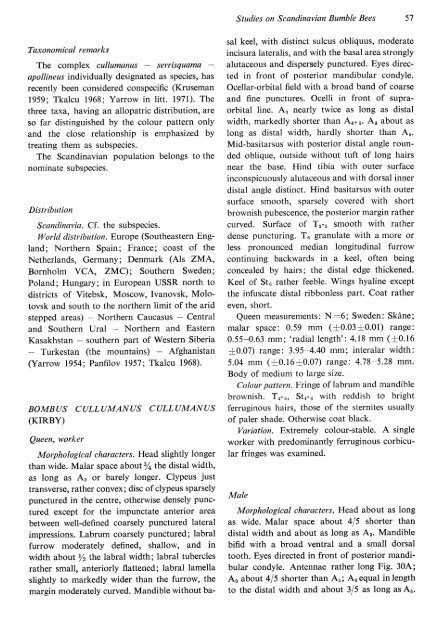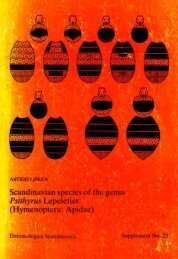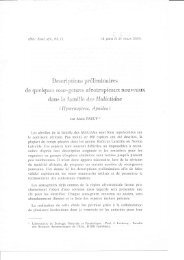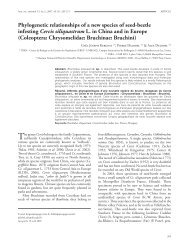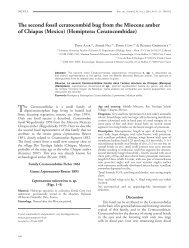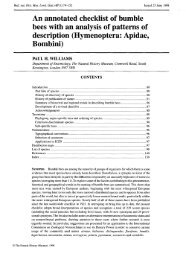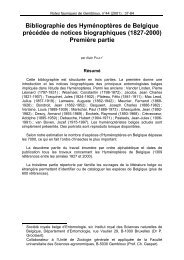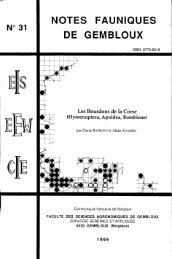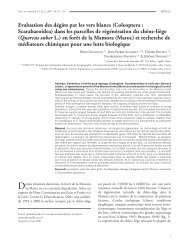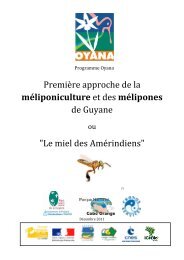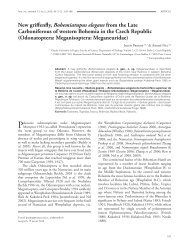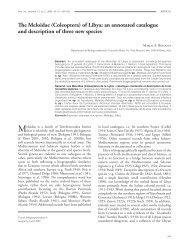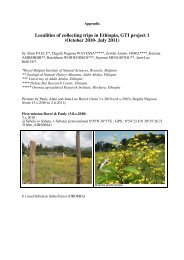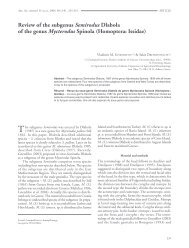Bumble Bees
Bumble Bees
Bumble Bees
You also want an ePaper? Increase the reach of your titles
YUMPU automatically turns print PDFs into web optimized ePapers that Google loves.
Studies on Scandinavian <strong>Bumble</strong> <strong>Bees</strong>s7Taxonomical remarksThe complex cullumanus serrisquamaapollineus individually designated as species, hasrecently been considered conspecific (Kruseman1959; Tkalcu 1968; Yarrow in litt. l97l). Thethree taxa, having an allopatric distribution, areso far distinguished by the colour pattern onlyand the close relationship is emphasized bytreating them as subspecies.The Scandinavian population belongs to thenominate subspecies.DistributionScandinavia. Cf. the subspecies.World distributiorc. Europe (Southeastern England;Northern Spain; France; coast of theNetherlands, Germany; Denmark (Als Zll4.A,Bornholm VCA, Z]|dC); Southern Sweden;Poland; Hungary; in European USSR north todistricts of Vitebsk, Moscow, Ivanovsk, Molotovskand south to the northern limit of the aridstepped areas) Northern Caucasus Centraland Southern Ural Northern and EasternKasakhstan - southern part of Western SiberiaTurkestan (the mountains) Afghanistan(Yarrow 1954; Panfilov 1957; Tkalcu 1968).BOMBUS CULLUMANUS CULLUMAI\IUS(KIRBY)Queen, workerMorphological characters. Head slightly longerthan wide. Malar space about t/a the distal width,as long as A, or barely longer. Clypeus justtransverse, rather convex; disc of clypeus sparselypunctured in the centre, otherwise densely puncturedexcept for the impunctate anterior ateabetween well-defined coarsely punctured lateralimpressions. Labrum coarsely punctured ; labtalfurrow moderately defined, shallow, and inwidth about /s the labral width; labral tuberclesrather small, anteriorly flattened; labtal lamellaslightly to markedly wider than the furrow, themargin moderately curved. Mandible without ba-sal keel, with distinct sulcus obliquus, moderateincisur a lateralis, and with the bas al area stronglyalutaceous and dispersely punctured. Eyes directedin front of posterior mandibular condyle.Ocellar-orbital field with a broad band of coarseand fine punctures. Ocelli in front of supraorbitalline. A, nearly twice as long as distalwidth, markedly shorter thal1 Aa+ s. Aa about aslong as distal width, hardly shorter than A5.Mid-basitarsus with posterior distal angle roundedoblique, outside without tuft of long hairsnear the base. Hind tibia with outer surfaceinconspicuously alutaceous and with dorsal innerdistal angle distinct. Hind basitarsus with outersurface smooth, sparsely covered with shortbrownish pubescence, the posterior margin rathercurved. Surface of Tr-u smooth with ratherdense puncturing. T6 granulate with a more orless pronounced median longitudinal furrowcontinuing backwards in a keel, often beingconcealed by hairs; the distal edge thickened.Keel of St o rather feeble. Wings hyaline exceptthe infuscate distal ribbonless part. Coat rathereven, short.Queen measurements: N -6; Sweden: Skine;malar space: 0.59 mm ( +O.O: +0.01) range:0.55-0.63 mrn; 'radial length': 4.18 mrn (+0.t0+0.07) range: 3.95-4.40 mm; interalat width:5.04 rnm (+0.16+0.07) range: 4.78-5.28 mm.Body of medium to large size.Colour pattern Fringe of labrum and mandiblebrownish. Tn- u, Stn- u with reddish to brightferruginous hairs, those of the sternites usuallyof paler shade. Otherwise coat black.Variation. Extremely colour-stable. A singleworker with predominantly ferruginous corbicularfringes was examined.MaleMorphological characters. Head about as longas wide. Malar space about 415 shorter thandistal width and about as long as Ar. Mandiblebifid with a broad ventral and a small dorsaltooth. Eyes directed in front of posterior mandibularcondyle. Antennae rather long Fig. 30A;A, about 415 shorter than Aul Aaequal inlengthto the distal width and about 315 as long as Au.


